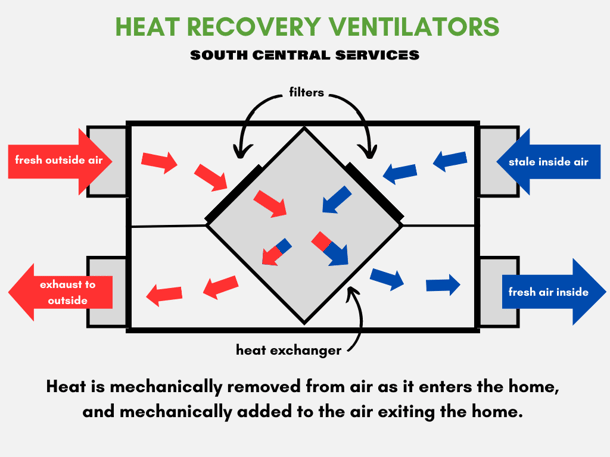A Simple Guide to HRV Upkeep
The All-Inclusive Overview to the Uses of Heat Recovery Ventilation in Modern Buildings
Heat Recovery Ventilation (HRV) systems stand for a considerable advancement in developing modern technology (HRV Heat Recovery Ventilation). They provide an approach for trading stagnant indoor air with fresh outdoor air while decreasing energy loss. This strategy not just enhances indoor air top quality however likewise adds to energy performance in both domestic and commercial buildings. Comprehending the various applications and benefits of HRV can disclose its important role in modern style and sustainability initiatives. The ramifications of this modern technology deserve checking out even more
Comprehending Heat Recovery Ventilation Systems

Although several modern buildings focus on power effectiveness, understanding warm recuperation air flow (HRV) systems is essential for enhancing interior air top quality and lowering power usage. HRV systems work by moving warm from stale interior air to inbound fresh air, successfully preserving comfy indoor temperatures while reducing power loss. These systems include a warm exchanger, fans, and ductwork that promote the blood circulation of air. During wintertime, HRV devices record and recycle warmth from the outbound air, while in summer, they can assist cool inbound air. By constantly exchanging air, HRV systems also lower humidity and the focus of indoor toxins. Appropriate setup and maintenance of HRV systems are vital for their efficiency and efficiency in boosting general building performance and comfort.
Benefits of Heat Recovery Ventilation
Heat recovery ventilation systems use various benefits that boost both energy efficiency and indoor air top quality in modern structures. By recording and recycling power from exhaust air, these systems greatly reduce heating and air conditioning costs, leading to reduced power consumption. They keep a stable circulation of fresh outside air, minimizing the threat of indoor air contaminants and allergens. This continuous exchange helps control humidity levels, avoiding mold development and ensuring a much healthier living environment. Furthermore, HRV systems add to sustainability goals by decreasing overall carbon impacts. Their capability to maximize ventilation without giving up thermal comfort makes them a beneficial addition to contemporary building design, advertising both financial and eco-friendly benefits.
Applications of HRV in Residential Structures
As home owners increasingly prioritize energy effectiveness and interior air high quality, the applications of warm healing air flow (HRV) systems in residential buildings have actually ended up being extra widespread. HRV systems are particularly advantageous in tightly sealed homes, where keeping fresh air circulation is crucial for protecting against dampness accumulation and indoor contaminants. They successfully transfer warmth from outward bound stale air to incoming fresh air, minimizing energy costs associated with cooling and heating. In addition, HRVs can boost convenience levels by regulating humidity and temperature. They are also adaptable for various household styles, including single-family homes and multi-unit structures. On the whole, incorporating HRV systems sustains lasting living techniques while making sure a much healthier indoor environment for passengers.
HRV in Business and Commercial Setups
In industrial and commercial settings, the application of heat recovery air flow (HRV) systems has come to be progressively vital for optimizing power effectiveness and keeping air high quality. These systems successfully transfer warmth from exhaust air to incoming fresh air, reducing the need for extra heating or cooling. This not just decreases More about the author power expenses but additionally adds to sustainability initiatives. Industries such as production, warehousing, and workplace buildings benefit greatly from HRV systems, as they aid control temperature level and humidity levels, making certain a comfortable and effective setting. Additionally, HRV systems help in removing contaminants and excess moisture, enhancing interior air high quality. As guidelines around air top quality come to be more stringent, the adoption of HRV technology is likely to grow, making it a vital component of modern-day commercial and commercial infrastructure.
Future Fads in Heat Recovery Ventilation Modern Technology

Frequently Asked Concerns
Just How Does Heat Recovery Ventilation Effect Indoor Air Top Quality?
Heat recovery ventilation considerably improves indoor air high quality by continually trading stale indoor air with fresh outside air while recouping energy. This process lowers toxins, keeps perfect humidity degrees, and assures a much healthier atmosphere for residents.
Can HRV Equipments Be Mounted in Existing Buildings?
HRV systems can undoubtedly be installed in explanation existing buildings. Retrofitting may call for alterations to ductwork and air flow formats, yet it considerably boosts power performance and indoor air high quality, making it a viable choice helpful hints for older structures.
What Upkeep Is Required for HRV Systems?

Are There Particular Climates Where HRV Is A Lot More Reliable?
Heat recovery ventilation systems are especially efficient in environments with substantial temperature differences between seasons. These systems maximize power effectiveness by recovering warmth from exhaust air, making them perfect for both cold and reasonably cozy settings.
Just How Do HRV Systems Affect Power Expenses?
